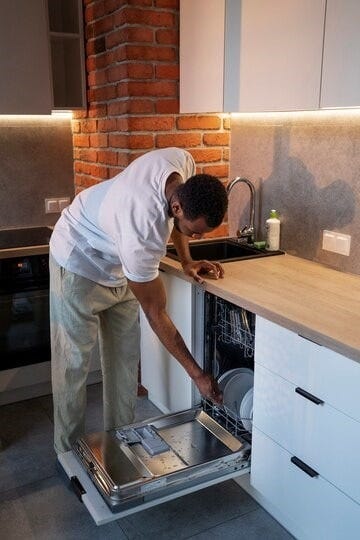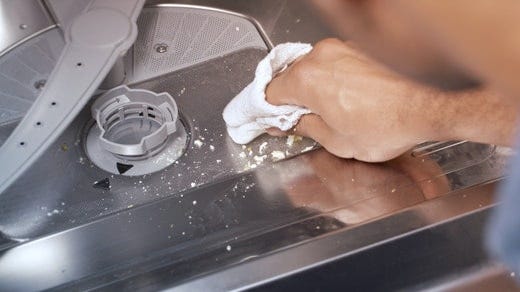
How to Clean Dishwasher Drain Trap
Discover Essential Tips and Techniques to Maintain Optimal Dishwasher Performance and Prevent Clogs.

In every home, the dishwasher is a valuable asset that saves time and effort in the kitchen. However, like any other application, it requires maintenance to function well and provide the cleanest dishes over time. Aside from the various maintenance that a dishwasher requires, the drain trap is one that must be maintained over time since food debris, grease and fat, soap residue, and so on can easily enter the drain or else the question that why water not draining from dishwasher will appear.
But what is the way of fixing a dishwasher that won’t drain? What does the method of dishwasher drain cleaner? That is how we came up with this guide on how to clean a dishwasher drain trap.
What Causes Dishwasher Drain Clogs?
Now, let's look at how and why dishwasher drains clog, so we may find an effective solution. So, there might be a variety of factors that obstruct the drain, including:
- Food Debris: When there is too much food left on the plates and they are placed directly in the dishwasher, food particles can gather in the drain and pipes, producing clogs over time.
- Grease and Fat: Once the food is prepared, the oil and fat particles might solidify and form a barrier in the drain, preventing the water from simply passing down the drainpipe.
- Soap Residue: The dishwasher utilises detergents to achieve the finest cleaned dishes, soap and foam can accumulate and form a film on the drain trap and pipes, which can make the barrier of the water to pass easily.
- Foreign Objects: During our everyday meals, if we leave leftover food or bones on the plates or dishes, they might get trapped in the drain and hinder the flow of water.
- Dirty Drain Filter: If the dishwasher drain filter from which the first phase of the used water goes by is blocked with food particles and not removed, it is fairly evident that not only will the dishwasher not drain fully, but your dishes may not be cleaned properly.
How Often to Clean a Dishwasher Drain Trap?
There is no fixed schedule for cleaning, but it is a good habit to clean the dishwasher's drainage pipe, once a month to ensure that you continue to receive the most fresh and clean dishes. If you let the drain to become clogged, the foul and dirty water may not be able to drain quickly, causing the dishes to smell terrible.
On the other hand, you should keep an eye on it on a regular basis and undertake the filter cleaning. If you detect any evidence of a blockage or if your dishwasher used water is not emptying fully.
How to Clean a Dishwasher Drain?
Step-by-Step Guide for how do you unclog a dishwasher drain trap:
- First, switch off the dishwasher: Before beginning this operation, make sure the dishwasher is turned off and removed from the power source to avoid mishaps.
- Second, remove the lower rack: To gain complete access and determine the location, remove the lower rack and open the drain trap found at the bottom of the dishwasher.
- Third, locate the drain trap: The drain trap is often a cylindrical or basket-shaped component that may be unscrewed or pulled out.
- Fourth, Remove Debris: If you find any food debris, oil, or other obstacles lodged in the drain, carefully remove it with your hands or a soft brush.
- Fifth, Clean the Drain Area: Using a Finish dishwasher cleanser or a vinegar and baking soda mixture, remove any buildup or debris around the drain trap to ensure adequate water flow out of the dishwasher.
Finally, clean the drain trap and surrounding area with warm water, and correctly reinstall the dishwasher components the way they were.
Additional Tips for Dishwasher Maintenance
If you don't want your dishwasher to reach the point where it says, "clean me," you risk putting your kitchen chores on wait. Instead, keep the following ideas in mind to ensure a seamless dishwasher experience.
- Use dishwasher-safe cleaning tablets: Maintain a habit of using Finish dishwasher-safe cleaning tablets to keep the dishwasher interior clean and clear of residue. This would help to avoid causing the circumstance to put your cooking job on wait.
- Schedule regular cleanings: Make it a practice to clean the dishwasher and drain trap frequently and run an empty cycle to avoid blockages and preserve maximum performance.
How to Prevent a Clogged Dishwasher Drain?
To avoid a blocked dishwasher drain, simply practice a few fundamental good habits.
- Scrape Food Scraps: To avoid clogging the drain, remove food scraps, bones, and oil before loading the dishwasher.
- Run Hot Water: Use proper hot water to rinse away the grease and fat in the sink before loading into the dishwashing machine, or just put the right hot water in the dishwasher to clean the dishes to assist dissolve oil and fat.
- Use Rinse Aid: Now, apply Finish rinse aid, which has a composition that reduces soap residue accumulation and prevents stains on dishes. So, employing a rinse aid can also enable you to allow the soap to remain in the drain and avoid clogging.
- Regular Maintenance: As previously said, if you want to enjoy the smoothest and cleaned dishes, periodically clean the dishwasher drain trap and inside to prevent blockages and maintain effective operation.
Why Isn't My Dishwasher Draining?
To get this question answered, there might be various reasons:
- Blocked Drain: A blocked drain trap or drain hose might prevent water from flowing correctly.
- Faulty Drain Pump: Another possible cause is a defective drain pump that is unable to adequately pump out water from the dishwasher after repeated usage.
- Blocked Air Gap: A clogged air gap might obstruct adequate draining by forming a hoover in the dishwasher.
- Blockage in the dishwasher's filter: Sometimes if the food particles are not removed from the filter, this might be the other most common reason for blocking the drain.
Fixing a Dishwasher That Won't Drain
Now, here's how you can fix the dishwasher drain:
Check the drain trap: As previously said, follow the instructions to clear the drain trap and remove any obstructions, then use the dishwasher as usual.
Inspect the drainage hose: It oversees draining the dishwasher; therefore, food and other debris will block the hose over time, especially if dishes are not pre rinsed before loading. Make that the drain hose is not kinked or blocked and is correctly attached to the drain.
Test the Drain Pump: Check the drain pump for any faults; it may need to be fixed or replaced. So that no unexpected events occur when it comes to drainpipe damage causing clogs.
In conclusion, as with any other application, adequate maintenance is essential and learning how to clean a dishwasher drain trap will help you avoid clogs and find a solution dishwasher not draining completely with guarantee your dishwasher runs well.
By using these recommendations, you can make your dishwasher's cleaning procedure smooth and easy to operate, allowing you to enjoy clean dishes and a well-maintained dishwasher for many years.










